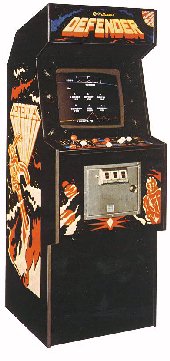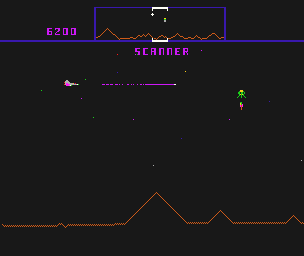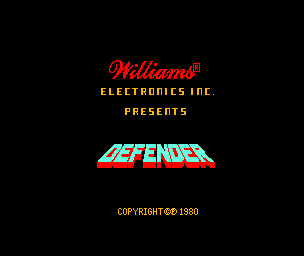
 The Game: Alien invaders besiege the helpless population of a planet, and you are the last line of defense. Ideally, you must destroy the aliens before they can abduct humanoids from the ground; if an alien ship gets to the top of the screen with a captive, it absorbs that unlucky soul and it becomes a much more dangerous and aggressive Mutant. Smart bombs give you the option to wipe out everything alien on the screen, but of course you only have three of them at the outset of the game. You can also perform an emergency hyperspace warp, but you could rematerialize in a far more perilous situation than the one you just left. When you go to the next level by eliminating an entire alien fleet, you receive a bonus multiplied by the number of humans who are still safely on the ground. (Williams Electronics, 1980)
The Game: Alien invaders besiege the helpless population of a planet, and you are the last line of defense. Ideally, you must destroy the aliens before they can abduct humanoids from the ground; if an alien ship gets to the top of the screen with a captive, it absorbs that unlucky soul and it becomes a much more dangerous and aggressive Mutant. Smart bombs give you the option to wipe out everything alien on the screen, but of course you only have three of them at the outset of the game. You can also perform an emergency hyperspace warp, but you could rematerialize in a far more perilous situation than the one you just left. When you go to the next level by eliminating an entire alien fleet, you receive a bonus multiplied by the number of humans who are still safely on the ground. (Williams Electronics, 1980)
Memories: For many people, Defender is the pinnacle of video games, hands down. Fast-moving, unrelenting, hard to beat but easy to become addicted, Defender was always a bit too fast for me – but it’s a perennial favorite for so many others.
 Defender begat a multi-part saga of Lucasfilm proportions. Next up was the very similar – but even harder – sequel Stargate (also commonly seen packaged as Defender II), which was followed by a ground-based run-and-shoot masterpiece called Robotron: 2084. The fourth and final entry in the Defender saga was a first-person space shooter called Blaster. Defender creator Eugene Jarvis was at least partially responsible for each of the four games in the Defender cycle.
Defender begat a multi-part saga of Lucasfilm proportions. Next up was the very similar – but even harder – sequel Stargate (also commonly seen packaged as Defender II), which was followed by a ground-based run-and-shoot masterpiece called Robotron: 2084. The fourth and final entry in the Defender saga was a first-person space shooter called Blaster. Defender creator Eugene Jarvis was at least partially responsible for each of the four games in the Defender cycle.
 Atari was the first company to snatch up the rights to Defender, turning out an Atari 2600 edition which was only slightly less screwed-up and flickery than the train wreck they sold under the name of Pac-Man. Versions for the Atari 5200,
Atari was the first company to snatch up the rights to Defender, turning out an Atari 2600 edition which was only slightly less screwed-up and flickery than the train wreck they sold under the name of Pac-Man. Versions for the Atari 5200,  ColecoVision and several home computers redressed the balance. Entex manufactured a handheld, battery-powered, LED-display version of the game around the same time. Defender has since resurfaced in a perfect emulation on Williams Arcade’s Greatest Hits.
ColecoVision and several home computers redressed the balance. Entex manufactured a handheld, battery-powered, LED-display version of the game around the same time. Defender has since resurfaced in a perfect emulation on Williams Arcade’s Greatest Hits.
